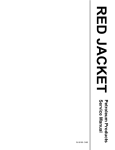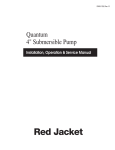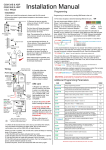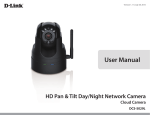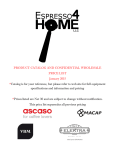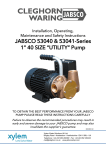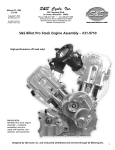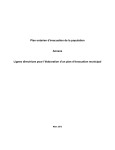Download Maxxum Big-Flo 6" Submersible Pump - veeder
Transcript
D051-301, Rev. E Maxxum Big-Flo 6" Submersible Pump Installation, Operation & Service Manual TABLE OF CONTENTS Table of Figures & Tables ......................................................................................................................ii About This Manual ................................................................................................................................iii Abbreviations and Symbols ..................................................................................................................iv CHAPTER 1: INSTALLATION ...................................................................................................................... 1 Installing the Pumping Unit ..........................................................................................................3 Attaching the Expansion Relief Vent Line .................................................................................... 4 Wiring the Conduit Box ................................................................................................................ 5 Wiring Instructions - 208-230 volt Single Phase Pumps .............................................................. 6 Wiring Instructions - 208-230, 400 or 575 Volt Three Phase Pumps ............................................7 Starting the Pump and Completing the Installation ......................................................................8 Wiring Instructions to Retrofit an Existing Site ............................................................................ 9 Installing a Big Flo Diaphragm Valve ..........................................................................................15 Attaching the Siphon Line and Vacuum Line with Factory Installed Siphon Assemblies ............16 Installing Two Pumps for Tandem Operation ................................................................................17 CHAPTER 2: TESTING THE INSTALLATION ..................................................................................................20 Testing Piping ..............................................................................................................................20 Testing Tank..................................................................................................................................21 Purging the System......................................................................................................................21 Adjusting the Line Relief Pressure ..............................................................................................21 CHAPTER 3: SERVICE AND REPAIR ..........................................................................................................22 Removing the Extracta Assembly ................................................................................................22 Procedure for Removal of Plug-In Type Pump-Motor Assembly..................................................23 Installing the Extracta Assembly ..................................................................................................24 The Check Valve Assembly..........................................................................................................26 Repairing the Check Valve Lock-Down Screw and Seals............................................................27 CHAPTER 4: CONTROL BOXES ................................................................................................................33 Motor Control Box for 2 HP Pumps, Model P200H1-CB ............................................................33 Magnetic Contactor for 2,3,4, & 5 HP 3 Phase Pumps ..............................................................34 APPENDIX A: MAXXUM RED JACKET STP SAFETY INSTRUCTIONS................................................................A-1 i TABLE OF FIGURES & TABLES Table A: Recommended Minimum Bypass ....................................................................................2 Figure 1 Attaching Expansion Relief Vent Line..............................................................................4 Figure 2 Wiring the Conduit Box ....................................................................................................5 Figure 3 Typical Mechanical Dispenser Wiring Diagram, 1Ø, Two-Wire Control ..........................9 Figure 4 Typical Mechanical Dispenser Motor control Box, Wiring Diagram, 2 HP ......................9 Figure 5 Wiring Diagram, Switched ‘Hot’ Feed, 208-230 Volts A.C., 2HP Single Phase Control Box ....................................................................................................10 Figure 6 Wiring Diagram, Three-Phase, Two-Wire Control ..........................................................10 Figure 7 Two-Wire, Three-Phase Motor Wiring Diagram ............................................................11 Figure 8 Three-Phase Motor Wiring Diagram ..............................................................................11 Figure 9 Three-Wire, Three-Phase Motor Wiring Diagram ..........................................................11 Figure 10 Backfill and Manhole Dimensions................................................................................12 Table B: Backfill and Manhole Dimensions ..................................................................................13 Table C: Winding Resistances......................................................................................................13 Table D: Floating Suction Installation Information ........................................................................14 Figure 11 Floating Suction Installation Diagram ..........................................................................14 Figure 12 Installing a Big Flo Diaphragm Valve ..........................................................................15 Figure 13 Attaching the Siphon Line and Vacuum Line with Factory Installed Siphon Assemblies........................................................................................16 Figure 14 Installing Two Pumps for Tandem Installation ..............................................................17 Figure 15 Wiring Diagram, Dual Manifold System, Two-Wire Control 208/230 Single Phase ....18 Figure 16 Wiring Diagram, Dual Manifold System, Three-Wire, 208/230 Single Phase..............18 Figure 17 Wiring Diagram, Dual Manifold System, Two-Wire control, Three-Phase....................19 Figure 18 Wiring Diagram, Dual Manifold System, Three-Wire Control, Three Phase................19 Figure 19 Testing the Piping ........................................................................................................20 Figure 20 Adjusting the Line Relief Pressure ..............................................................................21 Figure 21 Removing the Extracta Assembly................................................................................22 Table E: Pigtail and Seal Parts ....................................................................................................23 Figure 22 Pump Repair Parts ......................................................................................................25 Table F: Repair Parts List ............................................................................................................25 Figure 23 Repairing the Check Valve Assembly ..........................................................................26 Figure 24 Repairing the Check Valve Lock-Down Screw and Seals ..........................................28 ii ABOUT THIS MANUAL This preface describes the organization of this manual, explains symbols and typographical conventions used, and defines vital terminology. This manual is for personnel who install Red Jacket submersible pumps for petroleum. It contains the information required for working in the pit. It also contains a table of figures, a list of abbreviations, appendixes with the warranty and parts list, and an index. ORGANIZATION This manual is organized into four chapters: Chapter 1: Installation provides safety notices and gives step-by-step instructions for installing and wiring the pump, tandem pumps and control boxes. It also describes how to adjust the Pressurstat™. Chapter 2: Testing the installation describes testing the various components of the system after it has been installed. Chapter 3: Service and Repair describes how to remove and replace a pump. Also Included, is information on repairing the Pressurstat™, check valve and lockdown screw. Chapter 4: Control Boxes describes specific information on control boxes, magnetic starters and magnetic contactors. TYPOGRAPHICAL CONVENTIONS The various symbols and typographical conventions used in this manual are described here. TERMINOLOGY The following defined terms are used throughout this manual to bring attention to the presence of hazards of various risk levels, or to important information concerning use of the product. DANGER Indicates the presence of a hazard that will cause severe personal injury, death, or substantial property damage if ignored. WARNING Indicates the presence of a hazard that can cause severe personal injury, death, or substantial property damage if ignored. CAUTION Indicates the presence of a hazard that will or can cause minor personal injury or property damage if ignored. NOTICE Indicates special instructions on installation, operation, or maintenance that are important but not related to personal injury hazards. iii ABBREVIATIONS AND SYMBOLS Chassis ground (see also GND) Earth ground Ω Ohm, resistance µF Microfarad (10-6 farad) AG Alcohol-gasoline blends C EPA Centigrade Environmental Protection Agency F Fahrenheit ft-lb Foot-pound GND Ground gph; gpm Gallons per hour; Gallons per minute hp Horsepower Hz Hertz ISO International Organization for Standardization kPa KiloPascals mm Millimeter N•m Newton-meter NEC National Electrical Code NFPA National Fire Protection Association NPT PH psi; psig SG SSU UL National Pipe Thread Phase Pounds per square inch; Pounds per square inch gauge Specific Gravity Saybolt Seconds Universal, a measure of viscosity Underwriters Laboratories Inc. UMP Unit motor pump; Pump-motor assembly VAC Voltage—alternating current V VDC Volt Voltage—direct current iv CHAPTER 1: INSTALLATION NOTICE This pumping system requires the following elements: 1. Discharge Manifold Assembly - Installed below grade (NEC/Class I, Group D, Division I area) 2. Motor-Pump Unit Assembly - Installed below grade (NEC/Class I, Group D, Division I area) 3. Control Box/Magnetic Starter An “all inclusive” name plate will be found attached to the Extracta Head and can be inspected by removing the manhole cover directly over the pump. An additional name plate will be found on the control box. NOTICE It is important to give the model number and serial number of this pump when corresponding with the factory for any reason. INSTALLATION SAFETY NOTICES ATTENTION INSTALLER: Read This Important Safety Information Before Beginning Work. DANGER WARNING Portions of this product are to be installed and operated in the highly combustible environment of a gasoline storage tank. It is essential that you carefully read and follow the warnings and instructions in this manual to protect yourself and others from hazards which will result in serious personal injury, death or severe property damage. Failure to follow all instructions in proper order can cause personal injury or death. Read all instructions before installing. All installation work must comply with local code requirements. If no other codes apply, the latest issue of the National Electrical Code should be followed. Installation of Red Jacket petroleum equipment should be performed only by personnel who are trained and qualified to do so. 1. Units should be installed with manholes, or with discharge manifold casting above grade, to allow for ease in servicing. WARNING Red Jacket line leak detection systems do not function if the submersible pump runs continuously. Running a pump continuously will cause line leak detection systems to not function which results in a hazard that can cause severe personal injury, death or property damage. —1— 2. Never wire a submersible pump to run continuously at less than minimum flow rate. The units are designed to operate continuously at or above minimum flow rate, or with an intermittent duty cycle, not to exceed 20 on/off cycles per hour. Should it be necessary to operate a unit continuously or when the demand is at a rate less than required per the information below, a bypass pipe should be installed in the piping to allow for continual product recirculation back into the storage tank. Regulation of the bypass flow back to the tank can be accomplished by correct sizing of the bypass line or use of a gate valve. The recommended minimum bypass per unit is: Table A 60 Hz 208-240, 575 VOLT TWO STAGE UNITS 50 Hz, 380-415 VOLT, THREE STAGE UNITS P200J1-2MB=15 GPM P300J17-3HB=20 GPM P200J4-2MB=15 GPM P500J17-3K=25 GPM P300J4-2HB=20 GPM P300J16-3HB=20 GPM P500J4-2K=25 GPM P500J16-3K=25 GPM P500J6-2K=25 GPM 3. Red Jacket submersibles are not designed to handle abrasives or foreign particles in the product being pumped. 4. Product temperature must never exceed 105°F (41°C) as the submersible motors are equipped with thermal overload protection. Product temperature higher than 105°F (41°C) may result in tripping of the thermal overload protector. 5. Pumping water will overload the motor and damage the motor bearings. 6. These units are designed for use in Class I, Group D atmospheres. 7. Install pumping system in accordance to applicable codes. WARNING Proper motor protection must be used on three phase pump models, or motor warranty is void. To maintain warranty, the magnetic starters used must be supplied by Red Jacket, or have equivalent protection features defined as follows: 3 leg protection, properly sized quick trip heaters, and ambient temperature compensated overloads. —2— FOLLOW THESE DIRECTIONS CAREFULLY NOTICE Check these points before installing. 1. The power supply against the equipment voltage rating. For 3 phase units, request the power company identify and tag the service wires for L-1, L-2, L-3 phase sequence. 2. Be certain that the pump with the siphon valve is installed into the correct tank. 3. Check the equipment which was received against the table on Figure 16 for the tank diameter and bury depth. CAUTION BEFORE INSTALLING PIPE THREADS APPLY AN ADEQUATE AMOUNT OF FRESH, UL CLASSIFIED FOR PETROLEUM, NONSETTING THREAD SEALANT 4. Apply thread sealant to the six inch riser/flange male threads. Thread it into the tank port. Tighten the riser/flange until the joint is water tight. INSTALLING THE PUMPING UNIT. REFERENCE FIGURE 1 1. Apply a gasket compound to the bottom surface of the manifold and press the gasket onto the manifold’s mating surface so the holes in the gasket and manifold align. 2. Coat the exposed surface of the gasket with gasket compound. 3. Lower the pumping unit into position utilizing the lifting eyes. Do not allow the gasket to contact the riser flange until the bolt holes in the flange are aligned with those in the manifold and the discharge port is aimed in the desired direction. 4. Insert three 3/4 inch bolts, provided, and torque them to 200 ft lb (271 N•m). —3— LIFTING EYES BOLT TORQUE 200 ft lb 3 PLACES MANIFOLD VENT LINE 3” NPT OR BSP DISCHARGE PORT 6” NPT RISER FLANGE FLANGE GASKET FIGURE 1 ATTACHING THE EXPANSION RELIEF VENT LINE. REFERENCE FIGURE 1. 1. Remove the metal protective shipping caps from the flare fittings. 2. Attach the vent line taking care not to cross thread the fittings. 3. Tighten the fittings 1/6 to 1/4 turn beyond hand tight. CAUTION Before installing pipe threads apply an adequate amount of fresh, UL classified for petroleum, nonsetting thread sealant. 4. Install the piping to the manifold discharge port. Pipe sealant should be used in this joint. NOTICE Installation of a ball valve is recommended on the discharge side of the pump or discharge of the “Big Flo” leak detector housing if used. This will aid in troubleshooting and line testing. Line check-valves are not required since the pump has a built in check-valve. However, whenever two pumps are manifolded together to the same discharge piping, check valves with expansion relief are required and should be installed in the discharge piping of each pump, as close to the pump manifold as possible. See instructions “INSTALLING TWO PUMPS FOR TANDEM OPERATION” and Figure 14. —4— O-RING GROUND WIRE SCREW GROUND WIRE CUP WASHER TERMINAL EXTERNAL TOOTHED WASHER POWER & THERMAL OVERLOAD LEADS TO PUMP Note: For European installations, the End User must use an ATEX EEX d IIB certified cable gland or stopping box. (1'' CONDUIT) CONDUIT FROM CONTROL BOX FIGURE 2 WIRING THE CONDUIT BOX. REFERENCE FIGURE 2. DANGER Always disconnect and lock out or tag out the power before starting to service the pump. 1. Connect the electrical conduit through the approved fittings to the conduit box. 2. Remove the conduit box cover. 3. Connect the wires from the power supply to the wires in the conduit box. 4. Install the ground wire if required. 5. Sparingly lubricate the o-ring before screwing the cover into the manifold. Use light grease, oil, or petroleum jelly. Replace the conduit box cover. Do not use pipe sealant on the conduit box cover threads. 5 WIRING INSTRUCTIONS - 208-230 VOLT SINGLE PHASE PUMPS The motor control box must be located away from the fueling area in a nonhazardous location (see Fig. 3). 1. Connect the single phase 208-230 V power supply from the distribution panel to terminals L1 and L2 in the motor control box. Each control box should be wired through a separate fused disconnect switch or circuit breaker (including neutral, when used), furnished by customer. 2. Using properly color coded wires, connect wires from the red, black, orange and two blue terminals on motor control box terminal strip to the corresponding color coded wires in the junction box of the proper submerged pump. The “on-off” control station must be of explosion-proof construction. Where loading racks and dispensers are served by the same submerged pump, the 2-wire switches must be connected in parallel so the submerged pump can be controlled from any dispenser or any loading rack. 3. Connect wires from terminal Blue-1 and terminal 3 in motor control box to dispenser control switches (if dispensers are used) and “on-off” switch at loading rack as shown in Fig. 3. 4. The pumps are equipped with a no-liquid, over-temperature switch in the motor and an overload switch in the motor control box which will cut out if the motor is overloaded. If the pump fails to operate, or stops, when there is sufficient product in the storage tank, check the manual overload reset switch in the control box cover. Wait 10 minutes for the overload protector to cool off and then press the reset button. CAUTION If the reset button will not stay in position this indicates an overloaded motor, or a short to ground. This condition must be corrected. If the reset button stays in but the motor will not pump or continue to run, the tank is dry. 5. If an external pilot light is desired to indicate when the submerged pump is operating, wire as shown in Fig. 3, 4 or 5. Should this light continue to burn when all switches at dispensers and loading racks are off, this indicates that one of the dispenser switches is out of adjustment. On installations with no external pilot light, the submerged pump should be checked to make sure it is not operating when all switches are turned off. 6. The magnetic contactor coil is shipped ready to accept 208-230 volts. No changes are required unless a 110-120 volt coil is desired. —6— WIRING INSTRUCTIONS - 208-230, 400 WARNING OR 575 VOLT THREE PHASE PUMP On some installations, “phase converters” are used to obtain a three-phase power supply from a single-phase power source. The use of phase converters may cause an imbalance between the three phases and cause damage to the motor. For this reason, these requirements must be followed in order to maintain warranty coverage. 1. Static phase converters must not be used. Only rotary or electric phase converters are allowed. 2. The horsepower rating or the phase converter must be equal to at least three times the horsepower rating of the pump(s). 3. Current imbalance must not exceed 10% under varying flow conditions. 4. Proper three-leg quick trip overlaods must be used. 1. Installations where the magnetic starter is located away from the loading rack in a nonhazardous location. (See Fig. 9.) a. Connect the three phase power supply from the master panel to terminals L1, L2 and L3 in the magnetic starter. b. Using properly color coded wires, connect a black wire from terminal T1 in the magnetic starter to the black motor lead, in the junction box of the proper submerged pump. Connect an orange wire from starter terminal T2 to the orange motor lead and red wire from terminal T3 to the red motor lead. (See Fig. 6 through 9.) c. The 279-327-5 magnetic starter is shipped with the coil wired to accept 208240 volts, 60 HZ. It may be rewired to accept 110-120 V. To connect 110-120 volts to the coil, rewire the coil per the wiring diagram label on the side of the contactor. Next, connect a wire from terminal V of the coil to neutral. The 279-230-5 magnetic starter is shipped with the coil wired to accept 575 V, 60 HZ. It cannot be rewired. The 279-231-5 magnetic starter is shipped with the coil wired to accept 190/240 V 50/60 Hz. It may be rewired to accept 380/460V 50/60 Hz. d. There are two remaining blue wires in the submerged pump junction box. Connect either blue wire to terminal L3 in the Magnetic Starter. Connect the other blue wire to one side of the “on-off” controls or switched “hot” from the electronic dispenser (See Fig. 8.) The “on-off” controls, if furnished by customer, must be of explosion proof construction. —7— e. Installations using mechanical dispensers must be connected for 2-wire control as shown on Fig. 6 and 7. Connect a black wire from the other side of the “on-off” switch to terminal 3 in the magnetic starter. f. Installations using loading racks only, may be connected for two or three wire control. (See Fig. 7 or 9). For three wire control, connect a black wire from terminal 3 in the magnetic starter to the “on-off” switch. Connect a red wire from terminal 2 in the magnetic starter to the “on-off” switch. . NOTICE WARNING 3-wire control requires the use of an auxiliary contact in the magnetic starter. This auxiliary contact is not standard equipment in the starters supplied by Red Jacket, and must be ordered as an option. Use Furnas auxiliary field kit 49D2125001 or equivalent. Installations with the magnetic starter in a hazardous location require explosion proof starters. The wiring is the same as for general purpose enclosures. g. Install proper overload heaters in magnetic starter. 2. Motor Rotation Where it is not convenient to predetermine the power supply phase rotation, proper rotation can be determined by pump performance. Pump head pressure and capacity will be considerably less than rated when rotating backwards. Connect the pump motor leads to terminal T1, T2 and T3 of the magnetic starter observing color code shown in Fig. 7, 8 or 9. With ample product in the tank and the system purged of air, start the motor and make a pressure gauge reading of the system pressure with the discharge valves closed; or, open one valve and calculate pumping rate. Next, reverse power leads at L1 and L2. Repeat either pressure or capacity tests, as described above. If results are higher than the first test, the rotation of the second test is correct. If the second test gives lower performance than the first, reconnect the power leads to L1 and L2 (as under test 1) for correct rotation. Where the power supply has been properly marked L1, L2 and L3 in accordance with accepted phase rotation standards, it is possible to predetermine the proper rotation of these units. The motor power leads are color coded black, orange and red, and if connected through the magnetic starter to L1, L2 and L3 respectively, the motor pump unit will rotate in the correct direction. It is recommended, however, that the performance tests always be made whether or not the power supply has been properly “phased out”. —8— P200R1, 208-230V, 2HP SINGLE PHASE 230V DOUBLE POLE MOTOR SWITCH 115 115 ORANGE PILOT LIGHT 115 VOLT 50 WATT MAX BLACK RED DIAL AND DOME LIGHTS LINE 1 LINE 2 ORNGE BLACK RED BLUE BLUE 1 2 3 ON-OFF SWITCH TO NEUTRAL OF 115/230V SUPPLY EXT PILOT BLACK BLUE CUSTOMERS 115 VOLT EXTERNAL PILOT LIGHT 50 WATT MAX TO NEUTRAL OF 115/230V SUPPLY LIGHTING CIRCUIT SEAL 115V LIGHTING CIRCUIT (WHERE NEEDED) FROM DISTRIBUTION PANEL MOTOR CONTROL AND PILOT LIGHT CIRCUIT LOCATE SEALS WHERE REQUIRED BY LOCAL CODE SEAL (BLUE)1 FIGURE 3 (BLACK)3 TYPICAL MECHANICAL DISPENSER REPRESENTATIVE WIRING DIAGRAM, 1Ø, TWO-WIRE CONTROL 208-230 VOLT CONTROL BOX RED BLACK 115 BLUE ORANGE BLACK L3 L2 LINE 1 L1 LINE 2 T1 CONTACTOR T2 RED ORANGE BLUE BLACK BLACK OVERLOAD RELAY RESET BUTTON RUNNING CAPACITOR BLACK RED RED RED BLUE BLUE ORANGE MOTOR BLUE LOW LIQUID PROTECTOR 2 3 WHITE WHITE 1 WHITE STARTING CAPACITOR 5 STARTING RELAY WARNING WHITE The control box must be grounded for personal safety. Refer to the National Electrical Codes and applicable local codes for proper grounding procedures. TWO WIRE CONTROL EXT PILOT BLACK 115V EXTERNAL PILOT LIGHT (50 WATT MAX.) BLUE BLUE 1 2 STOP MAKE GROUND CONNECTION IN ACCORDANCE WITH LOCAL CODES RED 2 BLUE 1 NOTE: APPROVED COMPONENT ONLY - TOTAL SYSTEM INSTALLED SHALL COMPLY WITH ALL LOCAL CODES. T3 BLK 115 CONTACTOR COIL TERMINALS RED 230V RED START 3 BLACK THREE WIRE CONTROL GROUND SCREW FIGURE 4 TYPICAL MECHANICAL DISPENSER MOTOR CONTROL BOX, WIRING DIAGRAM, 2 HP —9— 208-230, 2HP 1Ø CONTROL BOX RED 230V BLUE ORANGE BLACK CONTACTOR COIL TERMINALS 115V COIL BLACK 115 L3 L2 LIME 1 L1 LIME 2 T1 CONTACTOR T2 RED ORANGE BLUE BLACK BLACK T3 OVERLOAD RELAY RESET BUTTON BLK 115 RUNNING CAPACITOR BLACK RED RED RED BLUE BLUE ORANGE NOTE: APPROVED COMPONENT ONLY - TOTAL SYSTEM INSTALLED SHALL COMPLY WITH ALL LOCAL CODES. MAKE GROUND CONNECTION IN ACCORDANCE WITH LOCAL CODES MOTOR BLUE LOW LIQUID PROTECTOR 2 HOT RED 2 BLUE 1 3 EXT PILOT WHITE WHITE WHITE 1 STARTING CAPACITOR 5 WARNING The control box must be grounded for personal safety. Refer to the National Electrical Codes and applicable local codes for proper grounding procedures. STARTING RELAY WHITE BLACK 115V EXTERNAL PILOT LIGHT (50 WATT MAX.) GROUND SCREW 1 Remove red wire (coil to L2). FIGURE 5 2. Relocate orange wire at L1 to coil. 3. Change to 115V coil assembly.. REPRESENTATIVE WIRING DIAGRAM FOR USE WITH SWITCHED “HOT” FEED 208-230 VOLTS A.C., 2 HP SINGLE-PHASE CONTROL BOX. 3-PHASE POWER SUPPLY WARNING The control box must be grounded for personal safety. Refer to the National Electrical Codes and applicable local codes for proper grounding procedures. V W LOCATE SEALS WHERE REQUIRED BY CODES NOTICE If 115V is not available from power supply, pilot lights may be operated from any 115V lighting circuit by controlling with a 4-pole starter. Otherwise, 230V pilot lights must be used. FIGURE 6 REPRESENTATIVE WIRING DIAGRAM, THREE-PHASE, TWO-WIRE CONTROL — 10 — WARNING The control box must be grounded for personal safety. Refer to the National Electrical Codes and applicable local codes for proper grounding procedures. The control box must be grounded for personal safety. Refer to the National Electrical Codes and applicable local codes for proper grounding procedures. WARNING Rewire coil for proper voltage. NOTICE 3-PHASE POWER SUPPLY 3-PHASE POWER SUPPLY BLUE L1 L2 L3 V BLACK L1 L2 L3 NEUTRAL “HOT” FROM DISPENSER SWITCHES AT LOADING RACKS AND/OR IN DISPENSERS CONNECTED IN PARALLEL COIL W V 115V COIL W BLUE T1 T2 T3 TO EXT. PILOT LIGHT 115V SUPPLY BLUE T1 T2 T3 RED ORANGE TO EXT. PILOT LIGHT 115V SUPPLY BLACK 3-PHASE POWER SUPPLY RED ORANGE BLACK THERMAL OVERLOAD 3-PHASE POWER SUPPLY THERMAL OVERLOAD FIGURE 7 NOTE: OBSERVE COLOR CODE L1, L2, L3 PHASE SEQUENCE FOR PROPER ROTATION OF MOTOR. FIGURE 8 TWO WIRE THREE-PHASE MOTOR WIRING DIAGRAM THREE-PHASE MOTOR WIRING DIAGRAM 3-PHASE POWER SUPPLY WARNING BLUE SWITCH AT LOADING RACK L1 L2 L3 NOTE: OBSERVE COLOR CODE L1, L2, L3 PHASE SEQUENCE FOR PROPER ROTATION OF MOTOR. STOP BLUE The control box must be grounded for personal safety. Refer to the National Electrical Codes and applicable local codes for proper grounding procedures. RED NOTICE START COIL BLACK V W NOTE: OBSERVE COLOR CODE L1, L2, L3 PHASE SEQUENCE FOR PROPER ROTATION OF MOTOR. BLUE T1 T2 T3 TO EXT. PILOT LIGHT 115V SUPPLY RED ORANGE BLACK 3-PHASE POWER SUPPLY 3-wire control requires the use of an auxiliary contract in the magnetic contactor. Furnas auxiliary interlock field kit 49D22125001 or equivalent. THERMAL OVERLOAD FIGURE 9 THREE WIRE THREE-PHASE MOTOR WIRING DIAGRAM — 11 — STARTING THE SYSTEM AND COMPLETING THE INSTALLATION 1. Do not start pumps unless ample product is in the storage tank. 2. Pump sufficient product through each dispenser to purge the entire system of air. If all air is not purged, the computers may “creep” slightly when the dispenser switch is turned on, but no product has been dispensed. 3. On pumps equipped with built-in siphon, it is necessary to run the submerged pump at least 10 to 20 minutes continuously to purge the air from the siphon manifold. 4. After the above checks have been made, the backfill can be completed and the manholes installed as shown in Fig. 10. 36.0 DIAMETER 18.0 RADIUS CENTER OF SUMP 9.6 4.0 MINIMUM 1.3 3” NPT OR BSP BY CONTACTOR 14.6 6” NPT RISER WITH FLANGE ORDER “A” BURY DEPTH “B” MAX RISER LENGTH SEPARATELY “D” “C” TANK DIAMETER 4.0 FIGURE 10 NOTICE Distance between center line of pump motor and center line of fill pipe should be 3’ minimum. Air locking of pump may occur at distances less than this distance. — 12 — Table B BURY DEPTH "A" RISER LENGTH "B" MAX TANK DIA. "C" 72" 84" 96" 120" 144" 30 in. 10 in. (883-442-1) PUMP LENGTH "D" 78" 90" 102" 126" 150" BURY DEPTH "A" RISER LENGTH "B" MAX TANK DIA. "C" 72" 84" 96" 120" 144" 36 in. 16 in. (883-445-1) PUMP LENGTH "D" 84" 96" 108" 132" 156" BURY DEPTH "A" RISER LENGTH "B"MAX TANK DIA. "C" 72" 84" 96" 120" 144" 42 in. 21 in. (883-449-1) PUMP LENGTH "D" 89" 101" 113" 137" 161" BURY DEPTH "A" RISER LENGTH "B" MAX TANK DIA. "C" 72" 84" 96" 120" 144" 48 in. 27 in. (883-449-1) PUMP LENGTH "D" 95" 107" 119" 143" 167" BURY DEPTH "A" RISER LENGTH "B" MAX TANK DIA. "C" 72" 84" 96" 120" 144" 60 in. 36 in. (883-451-1) PUMP LENGTH "D" 104" 116" 128" 152" 176" BURY DEPTH "A" RISER LENGTH "B" MAX TANK DIA. "C" 72" 84" 96" 120" 144" 72 in. 51 in. (883-454-1) PUMP LENGTH "D" 119" 131" 143" 167" 191" Table C Model Number Pump Motor Assembly Winding Resistances (OHMS) HP Volt Phase Orange to Red Orange to Blk Red to Blk Blue to Blue UMP200J1-2MB 2 208-230 1 5.4-6.2 1.5-2.0 6.9-8.2 0.0-1.0 UMP200J4-2MB 2 208-230 3 2.3-3.2 2.3-3.2 2.3-3.2 0.0-1.0 UMP300J4-2HB 3 208-230 3 1.7-2.3 1.7-2.3 1.7-2.3 0.0-1.0 UMP300J17-3HB 3 380-415 3 7.5-9.1 7.5-9.1 7.5-9.1 0.0-1.0 UMP500J4-2K 5 208-230 3 1.0-1.1 1.0-1.1 1.0-1.1 0.0-1.0 UMP500J17-3K 5 380-415 3 3.6-4.4 3.6-4.4 3.6-4.4 0.0-1.0 UMP500J6-2K 5 575 3 5.8-7.0 5.8-7.0 5.8-7.0 0.0-1.0 NOTICE The above readings do not include the added resistance of the power supply wires to the submersible pump. Therefore, in order for the readings to fall within the above limits, the resistance should be checked at the submersible pump junction box. If the resistance readings are taken at the control box or magnetic starter, they will be sightly higher DANGER Always make a complete power disconnect before taking resistance readings. — 13 — Table D HP Volts Phase Branch Ckt. Protection Wire Size for Max Length of Run Shown Fusetron Ckt. Brkr. (From Service Entrance to Pump In Feet) (Amps) (Amps) (Amps) No. 14 No. 12 No. 10 No. 8 No. 6 Service Factor Cur. Locked Rotor Cur. (Amps) Nema Codes 2 208-230* 1 12.0 61.0 20 20 172 274 929 673 1048 H 2 208-230* 3 7.2 45.0 15 15 361 574 899 1410 2197 K 3 208-230* 3 10.5 62.0 15 20 255 406 635 997 1552 K 3 380-415 3 5.4 29.0 15 15 787 1250 1956 3070 -- K 5 208-230* 3 17.2 92.0 25 30 -- 240 376 590 920 J 5 380-415 3 8.8 49.0 15 15 472 750 1173 1841 2867 G 5 575 3 7.0 37.0 15 15 929 1477 2311 3627 -- K *Figures represent maximum length in feet for 220 or 230 volt system. Use 75% of length for 208 volt system. FLOATING SUCTION INSTALLATION INFORMATION NOTICE Red Jacket only supplies the adapter. NOTICE Red Jacket pumps are centrifugal type and as such are not designed to pump product when level is below the bottom of the pump. NOTICE Before installing pipe threads apply an adequate amount of fresh, UL classified for petroleum, non-setting thread sealant. PUMP 4.0 APPROX. 3” NPT MALE THREAD FIGURE 11 — 14 — INSTALLING A BIG FLO DIAPHRAGM VALVE. REFERENCE FIGURE 12 The installation described herein is for a single pump system. If two pumps are to be installed in tandem contact your service representative for instructions for your specific system. WARNING 1. Since the leak detector only checks for leaks down stream from itself it should be installed as close to the pump as possible while still maintaining clearance for the removal of the pump check valve housing. 2. Install the “Big-Flo” diaphragm valve per the instructions included with the “Big-Flo” Diaphragm Valve. 3. Install the vent line from the FXV to the 1/4 NPT port in the six inch flange using tubing and fittings supplied with the leak detector. 4. Test the installation per the instructions included with the “Big-Flo” diaphragm valve. NOTE: IF BIG FLO VALVE IS INSTALLED IN SEPARATE SUMP, A PASSAGE WAY MUST RUN BETWEEN THE TWO SUMPS. THE FX VENT LINE CAN BE EASILY ROUTED BACK TO THE TANK THROUGH THIS PASSAGE WAY. 48” DIAMETER SUMP 11.0 1.8 18.3 13.0 2.0 1.5 3” NPT FLANGED BIG FLO VALVE (117-182-5). TO BE USED IN CONJUNCTION WITH THE FX SERIES LEAK DETECTOR CENTER OF RISER CENTER OF SUMP 20.5 16.5 FX LEAK DETECTOR VENT LINE 4.0 MINIMUM FIGURE 12 6” NPT FLANGED RISER 3” NPT BALL VALVE (RECOMMENDED FOR SERVICE) — 15 — STORAGE TANK VACUUM LINE MINIMUM 3/8” TUBING TO HIGH POINT OF PIPING SYSTEM SEE CLOSE-UP MINIMUM 2” NPT SIPHON LINE BY CONTRACTOR MUST PITCH UPWARD (TO TANK WITH PUMP) ABOUT 1/8” PER FOOT. VENT PIPE SIPHON LINE CHECK 3/8” TUBING VALVE ELBOW 3/8” NPT ELBOW FILL PIPE 3/8” BUSHING 1/4” NPT NIPPLE SIPHON NOZZLE 3/8” TUBING PROVIDED BY CONTRACTOR 3” NPT LINE TO DISPENSER 3” (76MM) FIGURE 13 3” (76MM) ATTACHING THE SIPHON LINE AND VACUUM LINE ON THE MAXXUM BIG FLO WITH FACTORY INSTALLED SIPHON ASSEMBLIES. REFERENCE FIGURE 13. 1. Remove the 1/4 inch pipe plug from the siphon nozzle. NOTICE CAUTION Care should be taken to insure that the internal portions of the siphon nozzle and parts included in the siphon kit are c lean and free of debris or contamination during assembly. Before installing pipe threads apply an adequate amount of fresh, UL classified for petroleum, non-setting thread sealant. 2. Coat both of the male threads of the 1/4 X 2 inch long nipple with pipe sealant. Thread one end of the nipple into the siphon nozzle and the other end into the 1/4 x 3/8 reduction bushing. 3. Apply pipe sealant to the male threads of the reduction bushing and thread it into the 3/8 female elbow. 4. Apply pipe sealant to the male threads of the siphon check valve and thread it into the 3/8 female elbow. 5. Apply pipe sealant to the male pipe threads of the compression fitting elbow and thread it into the 3/8 hole in the siphon check valve. — 16 — INSTALLING TWO PUMPS FOR TANDEM OPERATION. REFERENCE FIGURE 14. When greater flow rates are needed, two pumps may be required in the same piping system by means of a manifold. If they are installed according to the illustration, a tandem system offers backup support so operations can continue if one pump stops working. Install the pump as outlined above with the following additions. 1. If a siphon system is required each pump must have 3/8 inch siphon vacuum line attached to the same location on the two inch siphon line. WARNING 2. Adjust the Pressurstat on both packers to maximum relief pressure by rotating fully clockwise. If maximum pump pressures are NOT a minimum of 5 PSI below the Pressurstat relief setting then proper check valves with pressure relief are required to be installed in the discharge line of each pump to prevent product from being pumped through the pressure relief system of the adjacent pump when it is not operating. NOTICE Installation of a ball valve is recommended on the discharge side of the pressure relief check valve. This will aid in troubleshooting and line testing. NOTICE The drawing shown here is to illustrate the requirement for in-line, pressure relief type check valves. It is not a recommended guide for installation of piping downstream of the check valves. PRESSURE RELIEF CHECK VALVES AS AN OPTION, INSTALL BALL VALVES DOWNSTREAM FOR TROUBLE SHOOTING AND MAINTENANCE FIGURE 14 — 17 — WARNING The check valves shown installed in the discharge line of each pump are necessary to prevent product from being pumped through the pressure relief system of the adjacent pump, if that pump is not running. This is because the expansion relief valve operates at below pump pressures. If check valves without pressure relief were used, there would be no provision for thermal expansion between the valves and the dispensers. It is preferable that the wiring allow both submersibles to operate simultaneously with any combination of dispensers turned on. To operate individually, the appropriate disconnect switch must be turned off manually. (See Fig. 15 through 18 for suggested wiring diagrams.) PUMP 2 PUMP 1 115 V RELAY ALLEN BRADLEY 700C201 DISPENSER SW. FIGURE 15 SUGGESTED DIAGRAM FOR WIRING DUAL MANIFOLD SYSTEM. TWO WIRE CONTROL. 208/230 SINGLE PHASE PUMP 2 PUMP 1 SWITCH AT LOADING RACK 115 V DELAY ALLEN BRADLEY 700C201 FIGURE 16 SUGGESTED DIAGRAM FOR WIRING DUAL MANIFOLD SYSTEM. THREE WIRE CONTROL. 208-230 SINGLE PHASE — 18 — VOLTAGE RATING OF RELAY COIL MUST MATCH POWER SUPPLY. RELAY DISPENSER SW. COIL COIL PUMP 2 PUMP 1 BLUE BLUE BLUE TO EXT. PILOT LIGHT 115V SUPPLY BLUE TO EXT. PILOT LIGHT 115V SUPPLY RED ORANGE BLACK RED ORANGE BLACK THERMAL OVERLOAD THERMAL OVERLOAD NOTE: OBSERVE COLOR CODE L1, L2, L3 PHASE SEQUENCE FOR PROPER ROTATION OF MOTOR FIGURE 17 SUGGESTED DIAGRAM FOR WIRING DUAL MANIFOLD SYSTEM. TWO WIRE CONTROL. THREE PHASE VOLTAGE RATING OF RELAY COIL MUST MATCH POWER SUPPLY. SWITCH AT LOADING RACK RELAY 208/230V OR 400V THREE-PHASE POWER SUPPLY COIL COIL PUMP 1 PUMP 2 BLUE BLUE BLUE BLUE TO EXT. PILOT LIGHT 115V SUPPLY RED ORANGE BLACK TO EXT. PILOT LIGHT 115V SUPPLY RED ORANGE BLACK THERMAL OVERLOAD THERMAL OVERLOAD NOTE: OBSERVE COLOR CODE L1, L2, L3 PHASE SEQUENCE FOR PROPER ROTATION OF MOTOR SUGGESTED DIAGRAM FOR WIRING DUAL MANIFOLD SYSTEM. THREE WIRE CONTROL. THREE PHASE — 19 — FIGURE 18 CHAPTER 2: TESTING THE INSTALLATION TESTING THE PIPING. REFERENCE FIGURE 19. DANGER Always disconnect and lock out or tag out the power before starting to service the pump. 1. Block the lines at each dispenser. (Trip the dispenser shear valve.) 2. Lock down the pump check valve by turning the check valve lock down screw clockwise as far as it will turn. CAUTION Excessive pressure (above normal test pressure of 50 - 55 PSI (345-380 kPa) may damage the pump check valve seat and other system components. 3. Apply the line test pressure at the line test port. [50PSI (345 kPa) maximum]. 4. After the completion of the test release the pressure by: a. Turning the check valve lock down screw counter clockwise as far as it will go. b. Turn the Pressurstat adjustment screw counter clockwise until the screw protrudes 3/4”, this will relieve the line pressure to “0” psi (see Figure 20). CHECK VALVE LOCKDOWN SCREW SCREW OUT NORMAL OPERATION 1” NPT PORT SCREW IN FOR LINE AND TANK PRESSURE TESTING 1/4” NPT LINE TEST PORT 1/4” NPT TANK PORT (2 - 180• APART) FIGURE 19 — 20 — TESTING THE TANK. REFERENCE FIGURE 19. 1. Lock down the pump check valve by turning the check valve lock down screw clockwise as far as it will turn. 2. Remove the Tank Test Plug from the riser flange. 3. Apply tank test pressure at the tank test port. 4. After the completion of the test, release the pressure by turning the check valve lock down screw counter clockwise as far as it will go. PURGING THE SYSTEM 1. Pump a minimum of fifteen gallons (57 liters) of product through each dispenser. 2. Start with the dispenser furthest from the pump and work toward the pump. PROTECTIVE COVER ADJUSTMENT SCREW (AS SHOWN “0-3” PSI SETTING) FIGURE 20 ADJUSTING THE PRESSURSTAT LINE RELIEF PRESSURE, (THE LINE PRESSURE AFTER THE PUMP STOPS). REFERENCE FIGURE 20. 1. All pumps are factory set to a line relief pressure of 23-28 PSI (160-195 kPa). 2. Remove the protective cover. 3. Adjust the relief pressure to the desired level. Turning the adjusting screw clockwise will increase the line relief pressure. With the adjusting screw fully down the line relief pressure should be from 40 to 45 PSI. With the adjusting screw all the way up the pressure should be from 0 to 3 PSI. — 21 — 4. The line relief pressure can be verified in three locations. a. The pressure can be observed from the control unit of the electronic line leak detector. b. The pressure can be observed by attaching a gauge to the impact valve. c. The pressure can be observed by attaching a gauge to the line test port. 5. After setting the desired line relief pressure replace the protective cap. DO NOT USE PIPE SEALANT. Tighten to just snug after the protective cover has fully bottomed out. CHAPTER 3: SERVICE REPAIR AND REMOVING THE EXTRACTA ASSEMBLY. REFERENCE FIGURE 21. DANGER Always disconnect and lock out or tag out the power before starting to service the pump. 1. Unscrew the 5/8 inch bolt and pull the yoke up and rotate it 90° counter clockwise 2. Unscrew and remove the four 1/2 inch Extracta retaining bolts. 3. Lift the Extracta straight up out of the manifold assembly using the lifting eyes. A vertical lift will ensure the O-ring in the manifold will not be damaged. LIFTING EYES 1/2-13 HEX BOLT 5/8-11 HEX BOLT YOKE-DISCONNECT (DISENGAGED AND ROTATED) CHECK VALVE LOCKDOWN SCREWED IN (OPTIONAL) FIGURE 21 — 22 — PROCEDURE FOR REMOVAL NOTICE OF PLUG-IN TYPE PUMP-MOTOR ASSEMBLY Not all installed pump/motor units will have a locknut securing the pump shell. Steps 3A and 12 can be skipped if no locknut is present. Step 1 Place pump in a horizontal position on a clean surface. Step 2 Block up under the 3-inch column pipe so that the pump/motor assembly is about 2 inches above supporting surface. Step 3A If a locknut is present; loosen setscrew in locknut. Unscrew the locknut from the discharge head. Slide the adapter tube up to expose the four hex head machine bolts. Step 3B Loosen and remove the four hex head machine bolts on the top of the pumping unit just above the shell and around the motor. Step 4 Do not let the pump roll. Using your hands, (do not use a wrench) hold pump at the extreme bottom end and use a slight up and down motion to pull the pump from the casting attached to the 3-inch pipe. NOTICE Step 5 Up and down motion to remove the pump unit should not be greater than 1/4 inch. Motion greater than 1/4 inch could damage a positioning dowel pin in the top of the motor. If the motor leads tend to stay plugged into the motor, finish removing the motor until the leads can be pulled out of the top of the motor by hand. (This is a “plug in” type connection). Verify the number of wires. If there are only three wires, the pigtail and conduit seal must be replaced with the proper 5-wire version. Table E HP Pigtail Buna Seal Seal & Pigtail Kit 3 213-065-4 110-038-4 213-065-5 5 213-069-4 110-038-4 213-069-5 WARNING Step 6 Installed pump/motor units with 3-wire pigtails must be upgraded to the proper 5-wire pigtail and conduit seal assemblies. Push the leads back into the casting on 3-inch pipe. CAUTION Match the projecting metal and rubber part of the plug in into the slot of the female receptacle. Step 7 Remove the block from the top of the new pump/motor. Step 8 Slip the new “O” ring (in the small envelope) into the groove on the casting that is still screwed to the 3-inch pipe. Oil the “O” ring with light lubricating oil (SAE-10). — 23 — Step 9 Look at bottom of the casting which remains screwed to the 3-inch pipe. Note the position of the one hex head bolt. Place the four machine bolts through the four bolt holes. NOTICE One hole (180 degrees away from the hex head) remains open, this is the locating pin hole. Step 10 Find the locating pin on top of the motor. This pin must go into the remaining open hole referred to in notice following Step 9. Step 11 Place the new pump/motor assembly in position by starting the locating pin into the hole referred to above. Gently push the motor into place until the shell starts to pass over the large “O” ring. Position the four machine bolts into the bolt holes and start threads. Draw all bolts down evenly until all are snug. After all bolts are snug, torque bolts to 24-34 ft-lbs. NOTICE Step 12 Draw all bolts down evenly until all are snug. This will help avoid damaging the connector and dowel pin. If a locknut is present; slide the adapter tube down over the discharge head so that it sets against the shell. Thread the locknut onto the discharge head and tighten until the adapter tube is firmly held in place against the pump shell. Torque locknut to 55-75 ft-lbs. Torque setscrew in locknut to 25-50 in-lbs. INSTALLING THE EXTRACTA ASSEMBLY. REFERENCE FIGURE 21. DANGER Always disconnect and lock out or tag out the power before starting to service the pump. 1. Inspect the lower o-ring in the manifold and the one in the lower face of the Extracta head. If they are nicked or otherwise damaged replace them. 2. Sparingly lubricate the lower o-ring located in the inside the manifold and the o-ring in the lower face of the Extracta head. Use light grease, oil, or petroleum jelly. 3. Lower the Extracta into position through the manifold assembly. Care should be taken to keep the unit as near to vertical as possible to avoid damaging the o-rings. Start the four 1/2 inch Extracta retaining bolts. DO NOT TIGHTEN THEM AT THIS TIME. 4. Rotate the yoke-disconnect into position so that the brass boss aligns with the disconnect port in the packer assembly. 5. Tighten the 5/8 inch bolt to fully engage the yoke. 6. Torque the four 1/2 inch Extracta retaining bolts to 50 ft lbs. (68 N•M) 7. Torque the 5/8 inch bolt to 50 ft lbs. (68 N•M) 8. Visually inspect the pumping unit for leaks while the pump is running. This is to insure that no seals or sealing surfaces were damaged during removal or installation of the Extracta assembly. — 24 — FIGURE 22 Table F Number Required Item Part No. Description 2 HP 3 HP 5 HP 1 036-043-3 Head - Motor Discharge 1 1 1 2 213-065-5 Pigtail & Conduit Seal - 2, 3 HP 1 1 -- 2 213-069-5 Pigtail & Conduit Seal - 5 HP -- -- 1 3 072-712-1 Pigtail O-ring 1 1 1 4 072-714-1 Motor Shell O-ring 1 1 1 5 026-179-1 Bolt - 3/8 -16 x 1 Hex 1 1 1 6 072-309-1 Receptacle Housing O-ring 1 1 1 7 031-328-1 Gasket Bolt 8 8 8 8 026-110-1 Lockwasher 3/8" Spring 4 4 4 9 026-184-3 Bolt - 3/8 -16 x 2-1/4 Hex-Gr. 5 4 4 4 10 038-241-3 Housing Pigtail 1 1 1 11 026-448-1 Set Screw Fastener - 1/4" 2 2 2 NS 001-157-3 Floating Suction Adaptor - HB -- 1 -- NS 001-026-3 Floating Suction Adaptor - K -- -- 1 NS 001-158-3 Floating Suction Adaptor - MB 1 -- -- Only the parts listed above are available for repairs of the lower end of the pump. If any other parts need replacing, order Red Jacket pump-motor assemblies. See page 33 for ordering numbers. — 25 — REPLACING THE CHECK VALVE ASSEMBLY. DANGER Always disconnect and lock out or tag out the power before starting to service the pump. NOTICE Close the ball valve in the discharge line if it has been installed. NOTICE Care should be taken to insure that the internal portions of the vent line and check valve assembly are clean and free of debris or contamination during servicing. 1. Relieve system pressure by removing the protective cover and then backing out the pressure adjustment screw. 2. Disassembly a. Loosen or disconnect the lower vent line fitting. b. Disconnect the upper vent line fitting. c. Remove the four 1/2 inch hex bolts. d. Pull the check valve housing assembly straight out of the manifold. 1/2-13 HEX BOLT PROTECTIVE COVER O-RING CHECK VALVE PRESSURE ADJUSTMENT SCREW THREAD PROTECTOR VENT LINE FIGURE 23 — 26 — 3. Assembly a. Be certain the two o-rings on the sealing face of the check valve housing are in place. b. Lower the check valve assembly back down into the manifold taking care not to damage the rubber seal on the check valve assembly. c. Install the four 1/2 inch bolts. Torque these bolts to 50 ft lbs. (68 N•M) d. Remove and discard the thread protector. e. Re-attach the upper vent fitting then tighten both the upper and lower fittings 1/6 to 1/4 turn beyond hand tight. 4. Readjust the pressure adjustment screw to the desired pressure setting. 5. Replace the protective cap. REPAIRING THE CHECK VALVE LOCK-DOWN SCREW REFERENCE FIGURE 24. AND SEALS. DANGER Always disconnect and lock out or tag out the power before starting to service the pump. NOTICE Care should be taken to insure that the internal portions of check valve housing are clean and free of debris or contamination during servicing. 1. Close the ball valve in the discharge line if it has been installed. 2. Lock down screw removal. a. Remove the four wiper housing retaining screws. b. Lift off the wiper housing from the lock-down screw. c. Remove the wiper from the wiper housing. Avoid damaging the bores in the housing. d. Unscrew the lock-down screw and remove it from the check valve housing. 3. Lock-down screw re-installation. a. Replace the two o-rings on the lock-down screw. These o-rings should be installed from the non-threaded end of the lock-down screw so as to avoid nicking or damaging the o-ring. — 27 — b. Sparingly lubricate the two o-rings before screwing the lock-down screw into the check valve housing. Use light grease, oil, or petroleum jelly. c. Using a flat piece of metal at least 1/2 inch larger than the OD of the wiper carefully drive the new wiper into the wiper housing orienting the wiper as shown in Figure 35. d. Sparingly lubricate the wiper ID lip before sliding it over the lock-down screw onto the check valve housing. Use light grease, oil, or petroleum jelly. e. Re-install the four #6 wiper housing retaining screws and torque to 20 in-lb. 4. Open the ball valve in the discharge line if it has been installed. PROTECTIVE COVER O-RING ADJUSTMENT SCREW 1/4 SCREWS W/LOCKWASHERS LOCKDOWN SCREW #8 SCREW PRESSURSTAT BODY WIPER SEAL SPRING PLUNGER WIPER HOUSING DIAPHRAGM O-RING FIGURE 24 VENT LINE DISCONNECTED AND ROTATED OUT OF THE WAY — 28 — 9 1 2 8 3 7 4 6 5 FIGURE 25 ITEM PART # DESCRIPTION 1 076-447-1 SCREW - ADJUSTMENT 1 2 080-944-1 SPRING-EXPANSION RELIEF 1 3 067-278-1 PLUNGER 1 4 017-573-1 DIAPHRAGM - EXPANSION RELIEF 1 5 072-642-1 O-RING (-112) 1 6 072-699-1 O-RING (-240) 1 7 026-752-1 LOCKWASHER 4 8 026-748-1 SCREW - HEX SOCKET 4 9 072-684-1 O-RING (-910) 1 — 29 — QUANTITY 6” MAXXUM BIG FLO - REPAIR PARTS PACKER MANIFOLD ASSEMBLY PARTS -SIDE VIEW 1 6 3 4 2 5 FIGURE 26 ITEM PART # DESCRIPTION 1 144-320-5 Kit - Lock Down Screw 1 2 112-267-5 Kit - Check Valve 1 3 072-695-1 O-ring (-366) 1 4 072-696-1 O-ring (-439) 1 5 031-334-1 Gasket Flange 1 6 144-321-5 Kit - 5 Wire Bushing 1 — 30 — QUANTITY 6” MAXXUM BIG FLO - REPAIR PARTS PACKER MANIFOLD ASSEMBLY PARTS -TOP VIEW 1 2 11 12 8 3, 3A SHOWN WITH SIPHON INSTALLED 7 4 9 10 - NOT SHOWN 5 FIGURE 27 6 ITEM PART # DESCRIPTION 1 036-470-1 Handle - Lifting 2 2 026-750-1 Bolt - Hex 1/2 - 13 x 1-1/2 6 3 144-307-5 Kit - Siphon Components 1 3a 066-163-3 Plug - Siphon Plug 1 4 026-759-1 Bolt - Hex 3/4 - 10 x 1-3/4 3 5 086-010-1 Line - Steel Vent 1 6 027-240-1 Plug - Square 1/4 NPT 1 7 027-276-1 Fitting - Tube 2 8 026-757-1 Bolt - Hex 1/2 - 13 x 1 4 9 067-265-1 Plug - 2" NPT with O-ring 1 10 072-686-1 O-ring (-228) 1 11 072-642-1 O-ring (-112) 1 12 144-322-5 Kit - Expansion Relief 1 — 31 — QUANTITY 6” MAXXUM BIG FLO - REPAIR PARTS YOKE ASSEMBLY 6 1 2 4 3 5 FIGURE 28 ITEM PART # DESCRIPTION 1 072-700-1 O-ring (-223) 1 2 072-689-1 Internal Retaining Ring 1 3 114-319-5 Kit - 5 Wire Connector Assembly 1 4 072-710-1 O-ring (-130) 1 5 072-697-1 External Retaining Ring 1 6 110-064-5 Conduit Box Assembly - 5 Wire 1 — 32 — QUANTITY CHAPTER 4: UL LISTED CONTROL BOXES MOTOR CONTROL BOX MODEL P200H1-CB FOR 2HP PUMPS DIMENSIONS: 4” Depth X 10.125” Width X 15.125” Length FIGURE 29 ITEM PART # DESCRIPTION QUANTITY 1 108-403-1 P200H1-CB Complete General Purpose Motor Control Box 1 2 071-047-1 Starting relay (3ARR3-J3V2) 1 3 071-061-1 Line Contactor Relay 1 4 011-085-1 Starting Capacitor (200MFD-250 Volt) 1 5 012-253-1 Running Capacitor (15MFD-370 Volt) 1 6 008-180-1 Terminal Block 1 7 071-062-1 Overload Protector (Cutler Hammer 10-2149) 1 8 023-009-1 Overload Protector Heater Element (Cutler Hammer 10177H-33A) (P200H1-CB) 1 — 33 — RED JACKET REPLACEMENT PUMP MOTORS Ordering Number Model Number HP Length in. (mm) Weight lbs. (kg) Volts Phase 882-839-5 UMP-P200J1-2MB 2 32.1 (815 mm) 116 (53) 208-230 1 882-840-5 UMP-P200J4-2MB 2 29.6 (752 mm) 116 (53) 208-230 3 882-842-5 UMP-P300J42HB 3 34.3 (871 mm) 120 (54) 208-230 3 882-211-5 UMP-P500J4-2K 5 42.5 (1080 mm) 162 (74) 208-230 3 883-434-5 UMP-P300J17-3HB 3 37.4 (950 mm) 125 (57) 380-415 3 886-511-5 UMP-P500J17-3K 5 47.0 (1200 mm) 167 (76) 380-415 3 883-226-5 UMP-P500J6-2K 5 41.1 (1050 mm) 162 (74) 575 3 UMP UMP WITH DISCHARGE HEAD 883-460-5 UMP-P300J17-3HB W/DH 3 40.1 (1020 mm) 135 (61) 380-415 3 886-454-5 UMP-P500J17-3K W/DH 5 49.7 (1270 mm) 182 (83) 380-415 3 MAGNETIC CONTACTOR FOR WARNING 2, 3, & 5 HP 3 PHASE PUMPS Three phase pump/motor units must have proper overload and quick trip heaters installed in the control box. HP Voltage HZ Control Box Heaters (3 Req.) Overload 2 208/230 60 279-231-5 036-072-1 061-018-1 3 208/230 60 or 036-076-1 061-018-1 5 208/230 60 279-327-5 036-080-1 061-018-1 5 575 60 279-230-5 036-100-1 061-018-1 3 380/415 50 279-231-5 036-070-1 061-018-1 5 380/415 50 279-231-5 036-074-1 061-018-1 — 34 — Appendix A: Maxxum Red Jacket STP Safety Instructions 1. ATEX Directive 94/9/EC approved Red Jacket Submersible Turbine Pump (STP) marked with the following information defining its limits for safe use. • Location Classification: CE 0539 Ex II2G EEx ds IIA T3 • Special Conditions for Safe Use: “The pump motor must not be allowed to run dry. This assembly must be used with appropriately certified equipment that ensures that the motor either remains fully submersed or that there is a continuous presence of fluid inside the pump motor.” • Certification Number: DEMKO 03 ATEX 0237289X 2. For European installations, electrical conduit must be connected through an ATEX EEx d IIB certified cable gland or stopping box. 3. Initial start-up of this pump requires that the pump motor be fully submersed in fuel. 4. The Red Jacket Maxxum Submersible Turbine Pump requires no periodic maintenance or calibration. A-1 By 125 Powder Forest Drive • Simsbury, CT 06070 Tel: (860) 651-2700 • Fax: (860) 651-2719











































